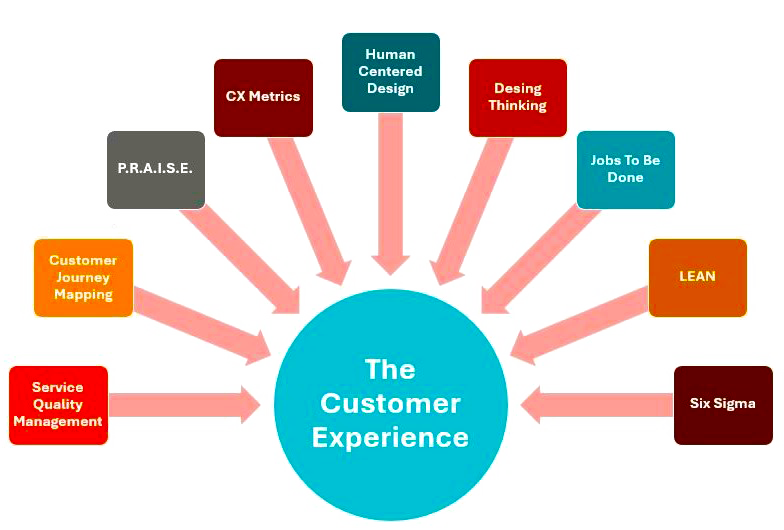The lexicon of Customer Experience Strategy and Management can sometimes be perceived as anecdotal, and “unscientific.” Frequently, terms like “experience,” “journey,” and “empathy” are used conversationally by business leaders, but not used as descriptors of true business disciplines. Customer Journey Maps – one of the most valuable tools a business can use, frequently become wall art.
Customer journey mapping is an essential tool for businesses aiming to understand how customers interact with their brand. It visualizes touchpoints, reveals pain points, and identifies opportunities for enhancing the experience. While traditional methods like Service Quality Management (SQM) are useful and have their place, they focus on transactional efficiency and performance. They often overlook the emotional and experiential aspects of customer interactions.
Key customer experience metrics such as Net Promoter Score (NPS), are good, but can lack context, and depth – especially if the survey question is delivered transactionally instead of in a relationship survey. When joined with Customer Satisfaction (CSAT), Customer Effort Score (CES), Sentiment Analysis, and Customer Lifetime Value (CLV), this provides a broader perspective on customer loyalty and engagement. This will help capture the full depth of a customer’s journey.
This is where my P.R.A.I.S.E. framework—Personal, Reliable, Authentic, Immersive, Seamless, and Easy—adds a crucial layer. Additionally, incorporating the Jobs to be Done (JTBD) methodology helps organizations uncover the fundamental motivations behind customer behavior.
By integrating SQM, CX metrics, P.R.A.I.S.E., JTBD, and process improvement methodologies like LEAN, Six Sigma, Human-Centered Design (HCD), and Design Thinking, organizations can create customer journeys that drive both operational excellence and deep emotional engagement, leading to increased loyalty, retention, and business growth.
The Role of Service Quality Management (SQM) in Customer Journey Mapping
SQM is a structured approach to assessing and improving service quality. It focuses on ensuring reliability, responsiveness, assurance, empathy, and tangible service attributes. The framework is built on closing five service-quality gaps, which are crucial in understanding the customer journey, and experience:
The Five Gaps in SQM:
- Gap 1: Knowledge Gap – The difference between customer expectations and a company’s understanding of those expectations.
- Solution: Conduct customer research, surveys, and feedback loops to align with actual customer needs and foster empathy.
- Gap 2: Policy Gap – The discrepancy between management’s understanding of customer expectations and the service standards they set.
- Solution: Design customer-centric policies based on real-world customer interactions, ensuring they reflect genuine customer empathy, not just operational goals.
- Gap 3: Delivery Gap – The inconsistency between service design and its actual execution.
- Solution: Invest in training, process improvements, and technology to ensure service consistency while empowering employees to act with empathy.
- Gap 4: Communication Gap – The gap between what a company promises and what it delivers.
- Solution: Align marketing and service teams to set realistic expectations and ensure transparency in messaging that resonates emotionally with customers.
- Gap 5: Perception Gap – The difference between what a company believes it delivers and what customers actually experience.
- Solution: Leverage customer feedback, sentiment analysis, and real-time data to continuously refine service delivery and create experiences that feel intuitive and empathetic.
Strengths of SQM:
- Standardization: Establishes consistent service processes.
- Measurement-Driven: Relies on data to assess service performance.
- Efficiency-Oriented: Focuses on reducing errors and improving response times.
- Customer Service Focused: Ensures frontline interactions meet quality standards.
Limitations of SQM:
- Lacks Emotional Depth: Primarily addresses tangible aspects of service but neglects how customers feel.
- Transactional Focus: Optimizes touchpoints individually but does not consider the overarching customer journey.
- Limited Differentiation: Fails to create deep brand loyalty based on emotional connections.
By integrating SQM into journey mapping, businesses can pinpoint these gaps at each touchpoint and systematically work towards bridging them.
Expanding Customer Experience Metrics Beyond NPS
While NPS measures customer loyalty by categorizing customers into Promoters (9-10), Passives (7-8), and Detractors (0-6), it lacks diagnostic depth. To gain a fuller picture of the customer journey, businesses should integrate:
- Customer Satisfaction (CSAT): Measures satisfaction with specific interactions, helping to refine particular touchpoints.
- Customer Effort Score (CES): Evaluates how easy it is for customers to complete tasks, identifying areas where friction should be reduced.
- Sentiment Analysis: Derived from your Listening Post Strategy, Sentiment Analysis extracts emotional context from customer feedback to assess overall brand perception.
- Customer Lifetime Value (CLV): Links CX performance to revenue impact, prioritizing efforts that drive long-term value.
When these metrics are overlaid onto journey mapping, they provide more actionable insights:
- A low CSAT score at a particular touchpoint suggests immediate service improvement is needed.
- A high CES score indicates excessive customer effort, requiring simplification.
- Sentiment analysis can reveal emotional disconnects that traditional metrics might miss.
- CLV insights help focus CX improvements on high-value customer segments.
The P.R.A.I.S.E. Framework: Humanizing the Customer Journey
My P.R.A.I.S.E. framework enhances SQM and CX metrics by addressing the emotional and psychological aspects of customer interactions. It ensures that customer journeys are not just efficient but also meaningful and engaging.
Components of P.R.A.I.S.E. and Their Role in Journey Mapping:
- Personal (P) – Tailoring experiences based on individual customer needs.
- Application: Use personalization (AI driven?) to provide relevant recommendations, content, and support, fostering a sense of empathy and understanding.
- Reliable (R) – Ensuring consistency in service delivery.
- Application: Measure and optimize performance metrics at each touchpoint to reduce variability in service quality while reinforcing a dependable, empathetic approach.
- Authentic (A) – Building trust through transparency and brand values.
- Application: Align brand messaging with actual service experiences, ensuring authenticity in communication that reflects a deep understanding of customer emotions.
- Immersive (I) – Engaging customers through multi-sensory, memorable experiences.
- Application: Utilize interactive content, gamification, and experiential marketing strategies that make customers feel valued and emotionally connected.
- Seamless (S) – Removing friction across all interactions.
- Application: Integrate systems to provide a unified experience across digital and physical channels, making transitions effortless and considerate of customer effort.
- Easy (E) – Simplifying interactions and reducing customer effort.
- Application: Streamline processes, minimize wait times, and enhance self-service options to reduce frustration and increase emotional satisfaction.
Integrating Jobs to be Done (JTBD) into Customer Journey Mapping
JTBD shifts the focus from improving interactions to understanding the fundamental motivations driving customer behavior.
Where JTBD Fits in the Customer Journey Mapping Process:
- Stage 1: Identifying Customer Needs & Motivations
- JTBD helps uncover the real reasons customers engage with a product or service.
- Example: A bank finds that customers aren’t just using mobile deposits for convenience but because they dislike in-person banking.
- JTBD helps uncover the real reasons customers engage with a product or service.
- Stage 2: Diagnosing Service Gaps with JTBD & SQM
- JTBD aligns well with SQM’s knowledge gap, ensuring service improvements address true customer objectives.
- Example: A meal subscription service realizes its customers’ primary “job” is to eliminate meal planning stress, not just save time.
- JTBD aligns well with SQM’s knowledge gap, ensuring service improvements address true customer objectives.
- Stage 3: Designing with JTBD & P.R.A.I.S.E.
- Instead of just making interactions smoother, P.R.A.I.S.E. ensures that every experience aligns with customer motivations.
- Example: If a fitness app’s “job” is to keep users engaged, Immersive (I) and Authentic (A) elements like gamification and expert-led guidance become essential.
- Instead of just making interactions smoother, P.R.A.I.S.E. ensures that every experience aligns with customer motivations.
- Stage 4: Scaling with JTBD, LEAN & Design Thinking
- JTBD aligns with LEAN and Design Thinking by emphasizing iterative testing and real-world application.
- Example: Using LEAN principles to create a seamless omnichannel experience in an e-commerce platform.
- JTBD aligns with LEAN and Design Thinking by emphasizing iterative testing and real-world application.
Integrating LEAN, Six Sigma, Human-Centered Design, and Design Thinking in Journey Mapping
- Stage 1: Identifying Touchpoints & Diagnosing Service Quality Gaps
- LEAN & Six Sigma eliminate inefficiencies and reduce service inconsistencies.
- Example: Using Six Sigma’s DMAIC process to improve customer service response times. (Define, Measure, Analyze, Improve and Control)
- LEAN & Six Sigma eliminate inefficiencies and reduce service inconsistencies.
- Stage 2: Measuring CX & Refining Pain Points
- Six Sigma & Human-Centered Design (HCD) refine customer sentiment analysis and pain points.
- Example: Using HCD to improve chatbot interactions for better emotional engagement.
- Six Sigma & Human-Centered Design (HCD) refine customer sentiment analysis and pain points.
- Stage 3: Designing & Prototyping Improvements
- Design Thinking & HCD enable ideation and rapid testing of experience enhancements.
- Example: Running a Design Thinking sprint to address high Customer Effort Score (CES) issues.
- Design Thinking & HCD enable ideation and rapid testing of experience enhancements.
- Stage 4: Scaling & Operationalizing the Experience
- LEAN, Six Sigma, & Design Thinking ensure continuous improvement and efficient roll-out.
- Example: Using LEAN principles to create a seamless omnichannel experience.
- LEAN, Six Sigma, & Design Thinking ensure continuous improvement and efficient roll-out.
Conclusion
By integrating SQM, CX Metrics, P.R.A.I.S.E., and JTBD, businesses can create holistic, data-driven, and emotionally engaging customer journeys that foster long-term loyalty, advocacy, and the associated ROI. But to do so, Executive Leadership in the Operations, Project Management, IT, HR, Sales, and Marketing disciplines need to be in the room and share ownership, and accountability for making it happen.





